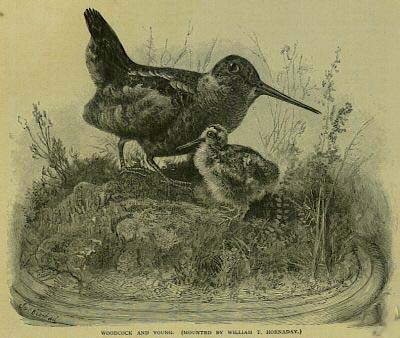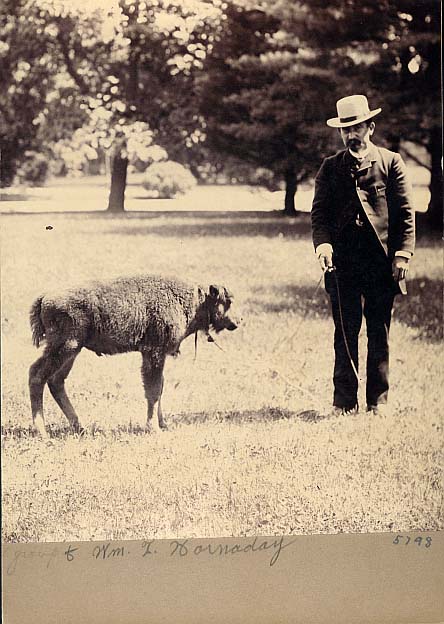Taxidermy4Cash.com
William T. Hornaday
We are always very interested in Purchasing Victorian Taxidermy, please respond via this on-line form of what you have for sale. HERE
Soul in the Skin.
The task of the taxidermist, if properly appreciated, is a grave and serious one. It is to impart to a shapeless skin the exact size, the form, the attitude, the look of life.
William T. Hornaday
If you’ve ever held a “buffalo nickel,” you’ve touched William Temple Hornaday’s legacy. The image on the nickel is the stuffed bison Hornaday created for the U.S. National Museum, now part of the Smithsonian Institution.
![HornadayPortrait[1].JPG](HornadayPortrait[1].JPG)
William T. Hornaday.
William T. Hornaday was born in Plainfield, Indiana on December 1, 1854. He attended Oskaloosa College in Iowa and Iowa State College in Ames, Iowa then became associated with Wards National Science Foundation in Rochester, N.Y in 1873. In 1874 he made his first collecting expedition for Wards to the Bahamas, Cuba and Florida. In 1876 he spent six months in the West Indies and South America and a short time later made a two-year tour of exploring and collecting for Wards in the Jungles of Ceylon, Malaya and Borneo. He married Josephine Chamberlain of Battle Creek, Michigan in 1879. In 1880, Dr. Hornaday founded the National Society of American Taxidermists and in 1882 was named the Chief Taxidermist of the National Museum (the Smithsonian), a position he held until 1890. Two years before he left he persuaded the museum to establish a living animals department and was so successful as the curator that the National Zoological Garden was established in Washington, D.C. When people above him radically changed his original plans for the Zoo, he resigned rather than be responsible for them. He left his zoological career at that point for a six-year stint as a businessman. He moved to Buffalo, N.Y. in 1890 where he started and ran a real estate business for six years. During those six years in Buffalo, N.Y., he served as a Trustee for the Buffalo Museum of Science. In 1896 he returned to his zoological career and became the first director of the New York Zoological Garden (the Bronx Zoo), which, under his supervision, became the largest and finest zoo in the world. He remained in that position for thirty years, retiring in 1926 at age 72. The New York Zoological Society is now known as the Wildlife Conservation Society (since 1994). In 1913 he created the Permanent Wild Life Protection Fund and raised $105,000.00 to endow it. Through the Fund, Dr. Hornaday did as much as any living man of his era to protect wild life. He was also one of the organizers of the Stamford Museum in Connecticut.
![hornadaybison[1].jpg](hornadaybison[1].jpg)
Bison by Hornaday.
William T. Hornaday also revolutionized how museums displayed wildlife exhibits. Before he came along they were simply mounted and placed on a board. He created and showed life like displays of wildlife in their natural settings. The first time he did this with monkeys it created a sensation. Surprisingly, Dr. Hornaday was at one time a big game hunter. In 1886 William T. Hornaday, the Chief Taxidermist of the US National Museum, led the ‘Smithsonian Institution Buffalo Outfit’ to Montana. The American bison was fast heading toward extinction and the mission of the expedition was to locate those of the elusive animals that remained and obtain specimens for the scientific collection at the museum

Woodcock by Hornaday.
He established the National Collection of Horns and Heads at the Bronx Zoo when it appeared big game animals would become extinct. That collection is now owned by the Boone & Crockett Club and is on display at the Buffalo Bill Historical Center in Cody, Wyoming. Dr. Hornaday is widely credited with saving the American bison and the Alaskan fur seal from extinction. He also played a large part in ending the use of feathers in women's hats. This alone saved millions of birds from slaughter. According to some sources, Dr. Hornaday was considered to be a bit eccentric in his day and he was involved in a highly controversial exhibit at the Bronx Zoo in 1906 that involved an African native named Ota Benga that ultimately ended in tragedy.
![buffalo-group_amnh[1].JPG](buffalo-group_amnh[1].JPG)
Bison by Hornaday.

Young Bison with Hornaday as a bystander.
The turn of the last century marked a time when the United States was in full growth mode; we were settling the West, tapping into the vast mineral and natural resources that our country provided us, and laying the foundation for the booming economic power that we were to become. One of those perceived "vast, inexhaustible" resources was wildlife, and the wave of economic prosperity that washed over the nation resulted in the wholesale slaughter of wildlife for commercial use. As we marched through the first decade of the twentieth century the situation got even worse.
Our history books have numerous stories of the waste that was laid for a buffalo robe or egret plume hats. Add to that the rapid loss of native grasslands and forests as well as the drainage of wetlands for agriculture to feed the growing nation, and you have a recipe for disaster.
And that's pretty much what happened. Wildlife across the country plummeted to the point where simply seeing a whitetail was notable since there was less than a half million of them nationwide. Wild turkeys were on the brink of extinction. Only 100,000 elk remained. Do I even need mention the passenger pigeon? Things were pretty bleak.
What turned the tide was an ethic, a model based on a series of principles that had their genesis even before market hunting decimated populations but didn't fully take root until things were at their worst. The two basic tenets of this North American Model are that the harvest of fish and wildlife is solely for the non-commercial use of any individual hunter or angler and that fish and wildlife populations will be managed to sustain optimal levels forever. But the concepts go much deeper and I can guarantee that they are the foundation for why we have it pretty good right now.
![buffalo-taxidermy[1].JPG](buffalo-taxidermy[1].JPG)
Bison framework ready for taxidermy.
Taxidermy4Cash does not undertake taxidermy, rather we are collectors of
other people’s work, both current and historical we also offer web hosting,
a search engine submission service and increasingly one of the larger
article resource banks on the net. So if your keen to learn about Taxidermy
etc, then you know where to look.
We are always interested to here about new resource, if you feel a resource
should be listed here then please contact us.
|
ITEMS
WANTED. Please respond via this on-line form HERE
with a description of what you have for sale.
[HOMEPAGE]
Taxidermy Links.
Please double click on the Taxidermy link icon below.
Taxidermy
Links
|
|
![hornadaybison[1].jpg](hornadaybison[1].jpg)

